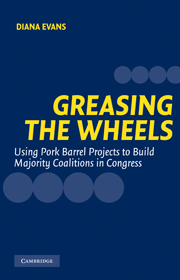Book contents
- Frontmatter
- Contents
- List of Tables and Figures
- Acknowledgments
- 1 Introduction
- 2 Pork Barrel Politics and General Interest Legislation
- 3 Who Calls the Shots? The Allocation of Pork Barrel Projects
- 4 Highway Demonstration Projects and Voting on the Federal Highway Program
- 5 Presidential Bargaining with Congress: The NAFTA Bazaar
- 6 Pork Barreling in the Senate: Do Both Parties Do It?
- 7 Conclusions
- References
- Index
7 - Conclusions
Published online by Cambridge University Press: 18 November 2009
- Frontmatter
- Contents
- List of Tables and Figures
- Acknowledgments
- 1 Introduction
- 2 Pork Barrel Politics and General Interest Legislation
- 3 Who Calls the Shots? The Allocation of Pork Barrel Projects
- 4 Highway Demonstration Projects and Voting on the Federal Highway Program
- 5 Presidential Bargaining with Congress: The NAFTA Bazaar
- 6 Pork Barreling in the Senate: Do Both Parties Do It?
- 7 Conclusions
- References
- Index
Summary
The argument of this book is that vote buying with pork barrel projects is useful, even essential, under some conditions for passing general interest legislation in a legislative body whose majority party leaders lack powerful sanctions for enforcing party discipline on each and every issue. The U.S. Congress is certainly such a body, despite its increasing partisanship. In his influential analysis of the role of parties in the House of Representatives in assembling majority voting coalitions, David Rohde (1991) describes a system of “conditional party government,” in which the party caucuses expect their leaders to use the tools in their possession to enforce discipline, but only on those issues on which broad intraparty agreement exists. Rohde explicitly recognizes that there are issues on which no such agreement exists (pp. 31–32); in such cases or where policy coalition leaders wish to buck the party leadership, they must use other resources to assemble a majority. Pork is one such resource. The preceding chapters show that it is one that is often effective at winning votes.
There are many potential opportunities for leaders to use this method of forming coalitions, despite the fact that the proportion of votes that is counted as party unity votes has risen over the past twenty-five years (Ornstein, Mann, and Malbin 2002, p. 172). The standard scoring system for a party unity vote requires only that a simple majority of one party vote in opposition to a simple majority of the other.
- Type
- Chapter
- Information
- Greasing the WheelsUsing Pork Barrel Projects to Build Majority Coalitions in Congress, pp. 223 - 244Publisher: Cambridge University PressPrint publication year: 2004

